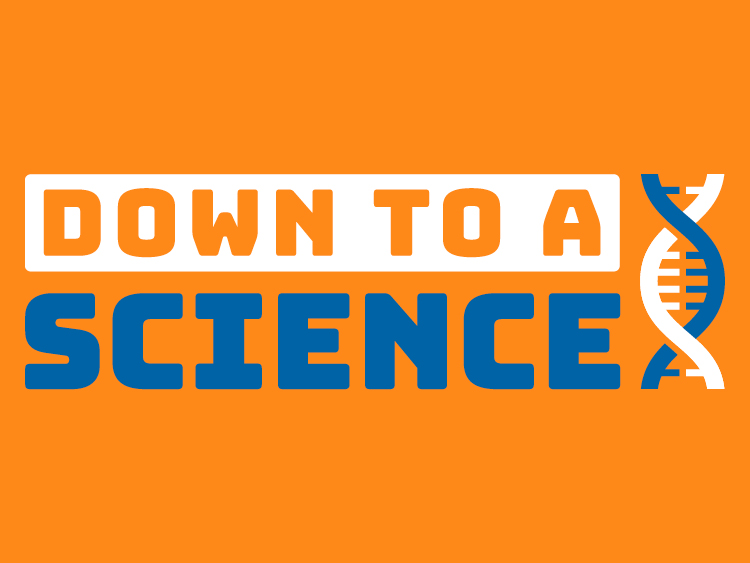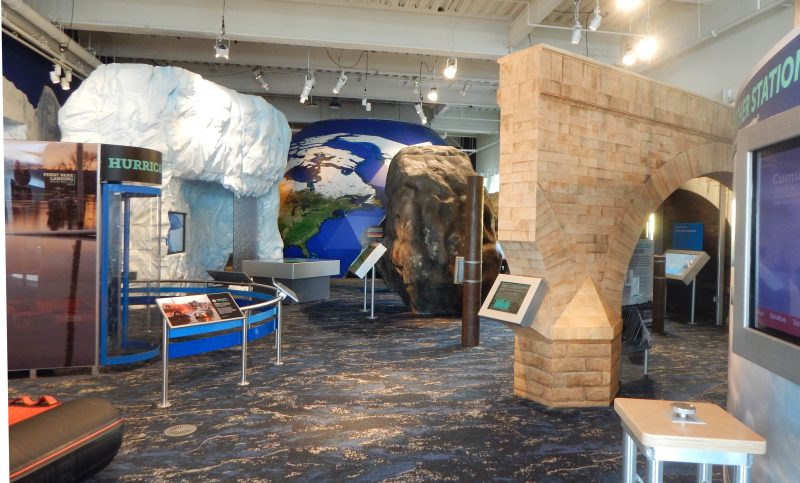
Have you ever wondered how the Connecticut Science Center’s exhibit galleries and exhibits are developed? Here is a behind the scenes tour of how our most recent gallery, Our Changing Earth, came into being.
Exhibit design is a way of telling a story, determining the most effective way to engage audiences in the topic. There are numerous elements and skill sets that go into an exhibit, including graphic design, industrial design, digital media, lighting, sound engineering, interior design, copywriting, and content development. And when an exhibit is really effective, you do not think about all of these individual contributions because the story just draws you in!
Creating an Exhibit
To start, we have to have an idea of the story that we want to tell. For Our Changing Earth, we began with the idea that our planet and its inhabitants – particularly humanity – are in an important relationship. We wanted to feature the idea that natural hazards (such as weather) and geological events (like plate tectonics) can significantly alter human populations and activities. We also wanted to highlight that human activities can also contribute to the frequency and intensity of some natural hazards. In particular, climate change is driven not only by natural effects but also by human activities. This relationship between earth and human impact is the story we wanted to tell – and how that story continues to be told today, shaping our planet, our environment, and our climate.
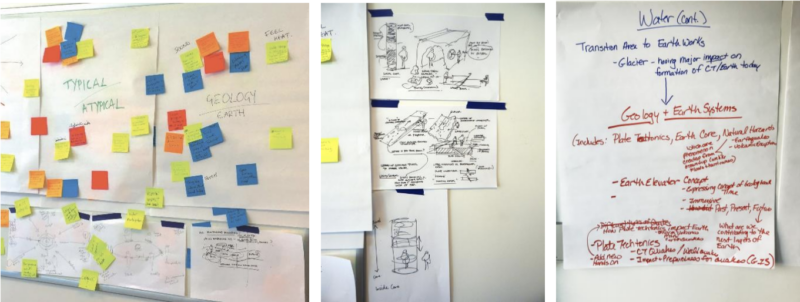
Once we determined the story to tell, we brought our Connecticut Science Center team together with exhibit designers to help us bring the story to life. An exciting part of the process is the brainstorming session where we talk about all of our ideas and dreams for the exhibit. Like all great creative processes, no idea is discounted. Once we have this list of great ideas, we start to narrow our focus – remembering the story we want to tell and the best way to communicate it to you. Some of the pieces of the final exhibit start to come into focus at this stage, as we consider large-scale iconic elements (like the glacier), wall murals, theatrical lighting, sound effects and even the floor (using carpet that looks like water) to help create an impression.
Once this creative process is complete, we have to translate this story into something we can build. We take initial concept sketches and refine them, ensuring that the goals and themes of the exhibit come through clearly. After that, we work with partners to create blueprints for building the exhibit. These plans go to a fabricator, who builds it for us. They will deliver the pieces of the exhibit, and a team installs it. Each exhibit is unique to the Connecticut Science Center – truly one of a kind.
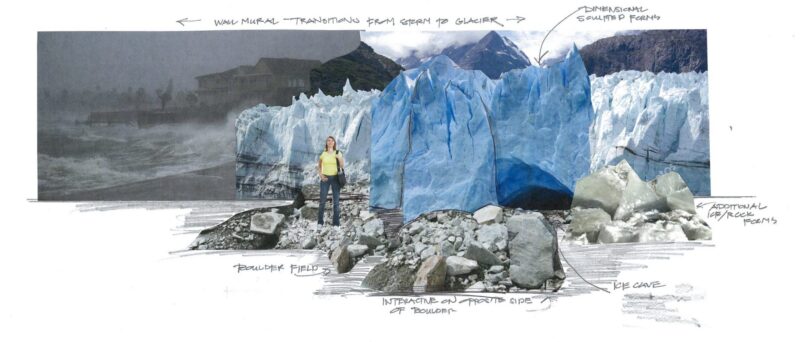
Conceptual Design Sketch

Design Refinement Elevation
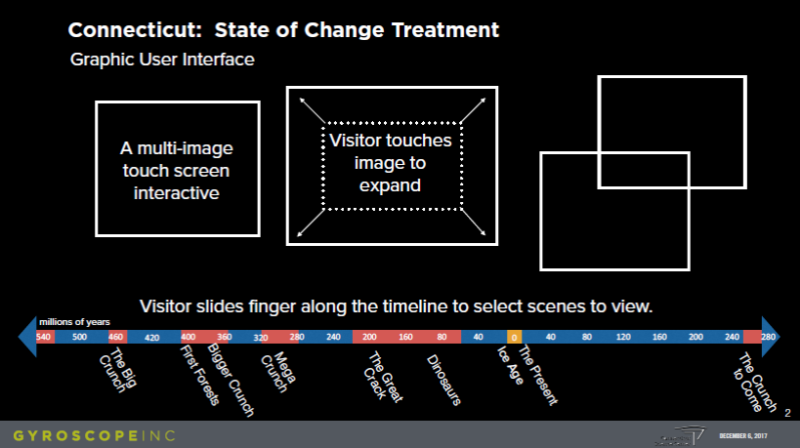
Media Storyboard
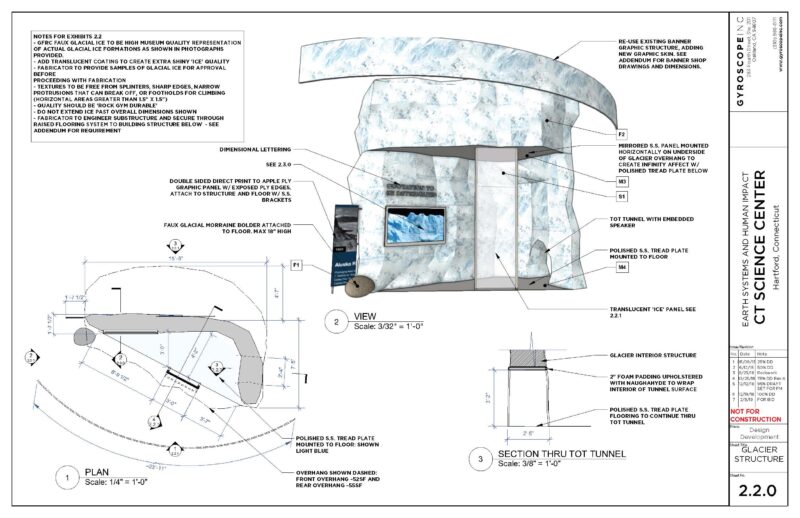
Preliminary Construction Drawing
This brief treatment of exhibit design sounds simple – but this process can take up to three years, countless conference calls, design ideas, good ideas, bad ideas, feedback loops, and more. The internal team included inputs from nearly every department. In total, over 65 people were part of bringing the exhibition to life.
What is the Science?
The scientific method has similarities to the exhibit design process. It is embedded in the beginning where different ideas are put forth, debated, and evaluated. Later in the exhibit design process, it appears in the creation of exhibit prototypes which are then tested and evaluated. There is also a significant amount of engineering and computer programming involved in the creation of the gallery. Alterations to our geodesic dome had to be engineered along with the very large pieces of the glacier and glacial erratics were designed to fit together and be self-supporting. The media interactives and mantle projection effect all required programming and exhaustive testing to insure their stability.
Putting it all Together

Most of the exhibit elements were fabricated off-site and brought in to be installed. However, there were some that had to be completed during installation, predominately the large-scale glacier and glacial erratics (the large stones deposited by glaciers). A talented team of prop makers and scenic painters were at the Science Center for a whole month putting sections of the glacier and erratics together, doing final sculpting and surface finishing and then applying scenic paint to give them their realism.

Another team of mural installers transformed our existing geodesic dome into a representation of the Earth. Our geodesic dome which represents the Earth, has 235 panels with each panel having its own graphic piece applied to it like a giant puzzle. The media production firm who created the amazing mantle effect in the dome and the interactive media presentations was onsite to do final checking of media-based exhibit performance.
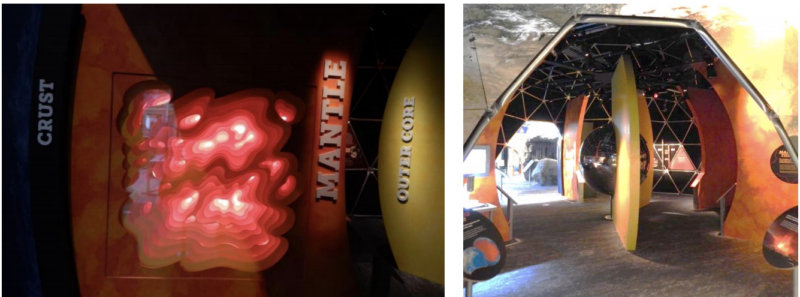
We also integrated some custom elements that are unique in their design and fabrication. The center of the Earth’s core is represented by a six-foot hollow stainless-steel sphere. There is an embedded three- dimensional sculpture of the Earth’s mantle alongside the dome’s entrance, made of laser-cut layers of paper, which was designed and fabricated in India.

Concept Design Sketch
The one aspect of the creation of Our Changing Earth that appealed to me the most is seeing it all come together on the gallery floor. This is when all the planning, scheduling, sketches, models, and countless revisions to the design are realized. The media development that was once confined to storyboards come to life on the screen. The once blank geodesic dome slowly evolves as a “blue marble Earth.” What began as a collage sketch of Bulkeley Bridge now rises from the floor, surrounded by new carpet emulating water. A line drawing of the glacier is now 15 feet high and glowing with scenic painted ice. And the best moment of all was when the ribbon was cut and our visitors were able to enjoy, engage and learn.
Stay connected! Be sure to subscribe to Down to a Science— The Official Blog of the Connecticut Science Center and follow us on social media.
Richard Thomas is the Exhibit Design Director at the Connecticut Science Center and guided the initial Science Center exhibits from inception to installation. He is a design generalist, having worked on projects that encompass industrial design, environmental graphics and signage, commercial interiors, and exhibition design. Richard has a BFA in Design from Syracuse University and an MFA in Design from Cranbrook Academy of Art, with additional studies at the Skowhegan School of Painting and Sculpture. The visual fine arts and applied design are his passion both professionally and personally.



